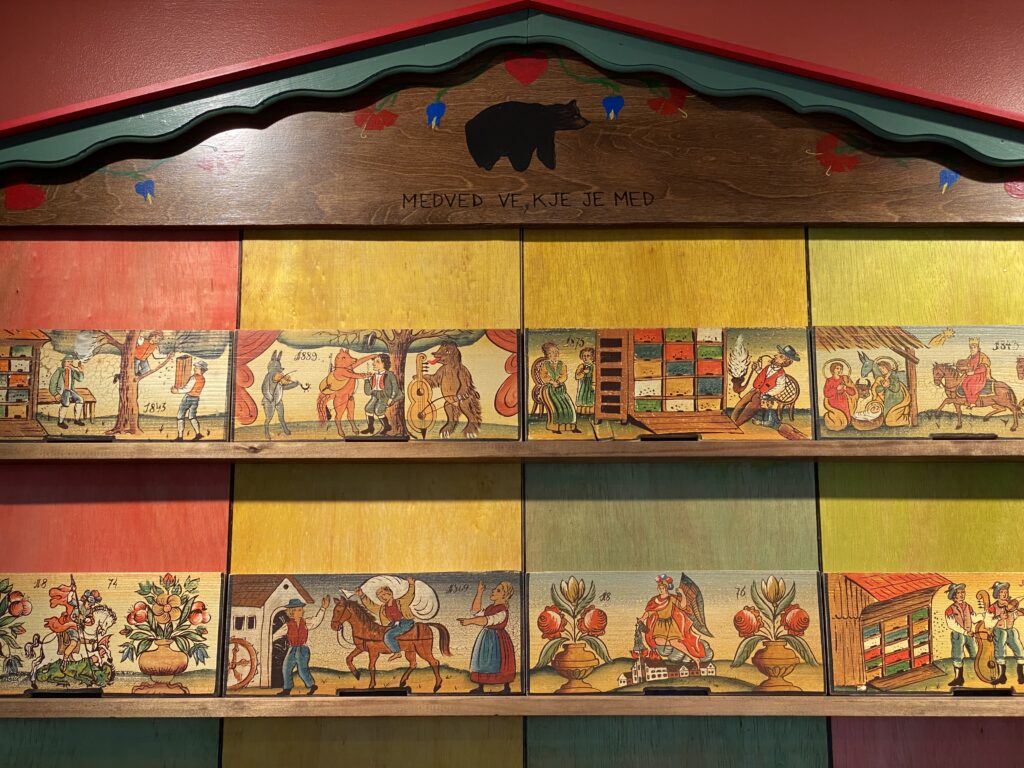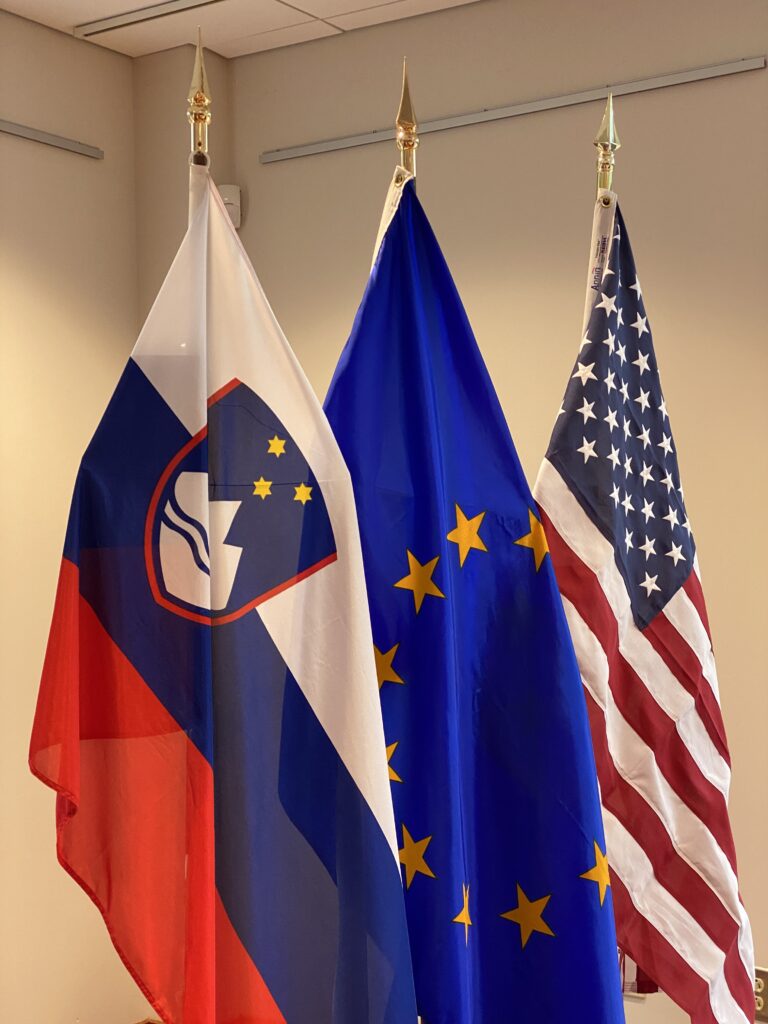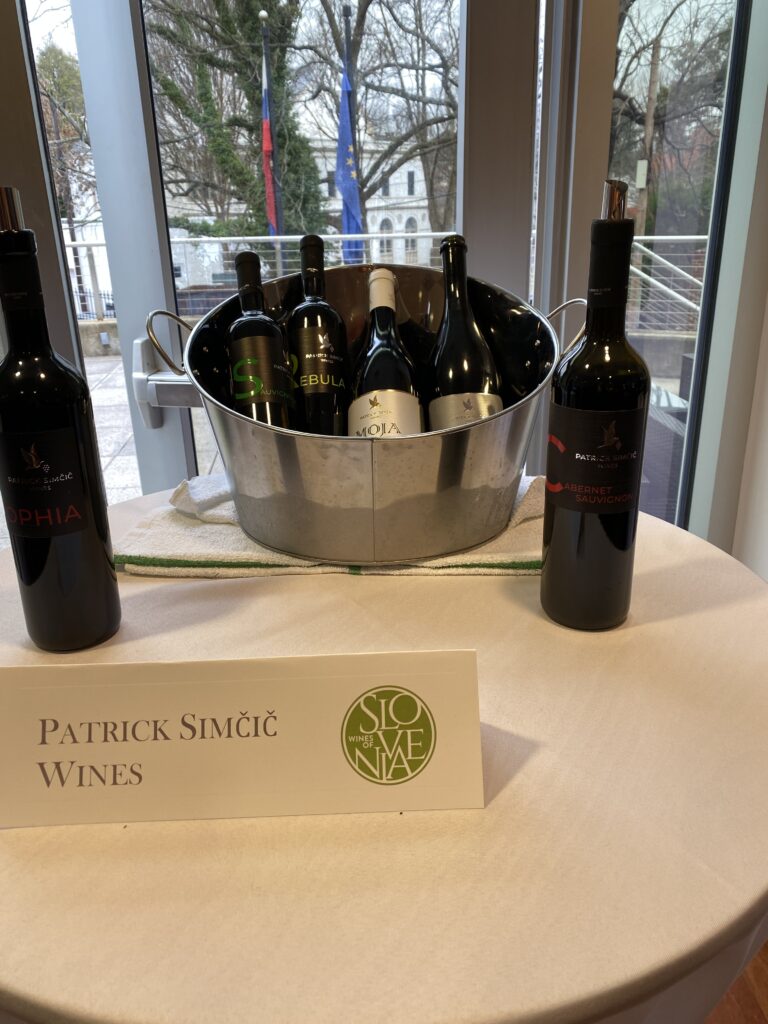We attended the “Wines of Slovenia” presentation at the Republic of Slovenia embassy in Washington, DC. In late January. The presentation by Andrey Ivanov, MS, was part of a four city tour that included Dallas, Chicago, New York and Washington, DC. We were warmly welcomed at the embassy and soon were guided to an event room. The embassy is simplified elegance. The room for the presentation was light and bright with three flags near the slide screen, including the Republic of Slovenia, EU and the US flags. Walls were decorated with large photos of Slovenian renowned views. Of particular interest to me was a large wall display of various painted wood pieces. Later I discovered, during the mid 1700s and 1800s beekeepers would decorate their hives with these folk art.

After a brief introduction, Andrey spoke of Slovenia’s geography and included what he felt were the major factors that influence grapevine growing. Slovenia’s northwest has the Julian Alps which bring in cooling factors. The southwest has the Adriatic Sea which brings warm air inland. The southeast has the Dinaric mountain range which brings coolness. The Pannonian Basin in the northeast brings a warming influence. Austria, Croatia and Hungary and Italy border the Republic of Slovenia.
History
Evidence has been found that a Germanic tribe was producing wine in the 3rd and 4th centuries in the region. The Romans continued this tradition of winemaking. The Archduke John of Austria began planting international grape varieties near the border in 1822. When Slovenia became part of Yugoslavia after WWII some vineyards became state-owned.
The Republic of Slovenia is home to what has been known as the oldest grapevine in the world. The vine is believed to have developed grapes as early as the beginning of the 16th or 17 centuries. The vine is located in Maribor and continues to bear fruit up to 121 pounds each year. The grape variety is considered a native grape, Žametovka. Imagine the history that this grapevine has seen in Central Europe, including Turkish rebellions, fires and wars. If the vine could write a book, what a story it would tell.
As of 2022 Slovenia’s total vineyard area was14.736 hectares (36,364.5 acres). The vineyards are managed by 26,400 growers. 2,700 producers are registered as commercial wine producers. Slovenian wines are exported to more than 40 countries by 150 producers.
Vineyards of Slovenia
Elevation of the vineyards are from sea level to 600 meters (1,969 feet). The vast majority of the vineyards on terraces and slopes thus necessitating most grapes harvested by hand. The soils vary and include: limestone, red karst limestone, marl, flysch and clay.
Slovenian Grape Varieties
Sixty grape varieties are grown in Slovenia. Currently the country has 38 white varieties and 22 red varieties. Many are familiar international grapes but there are others that Slovenia calls native grapes.
After the presentation, a light lunch was offered to participants. Small tables with several Slovenian wine producers were set up for additional wine tastings. Each bite was tasty and paired well with the Slovenian wines.
When visiting your local wine shop, ask about Slovenian wines. You may be pleasantly surprised by what you find. If traveling to the Republic of Slovenia, be sure to include adding a visit to a winery to your itinerary.
A Brief Look at 9 Slovenian Wineries
Slovenian wineries represented at the Slovenian embassy in Washington, DC included: Patrick Simcic Wines, Dveri Pax “Gates to Peace”, Pullus, Ronk Winery, Kristancic Winery, Vina Cuk’s family vineyard, Albiana Wines, Istenic and Klet Krško Winery.
Klet Krško Winery
The Klet Krško Winery is a collective with about 200 families participating. The cooperative was established in 1928. They also have 15 hectares (37 acres) of privately owned vineyards that are planted with Blaufränkisch, Pinot Blanc and Sauvignon. The location of the Klet Krško wine cellar is an old castle cellar that dates back to 1770. Klet Krško Winery is known for its large production of Cvi?ek, a very popular blend of red and white grapes. The winery claims to have the largest Cvi?ek cellar in the world.
Wine enthusiasts are encouraged to visit Klet Krško Winery as the winery offers winery tours and wine tastings. Visitors may choose between Classic, Premium and Gourmet tours.
Patrick Simcic Wines
Patrick Simcic Wines, family owned, was formed in the 1950s in Biljana. Great-grandparents moved to the village and began tending one hectare (almost 2.5 acres). Years later grandparents continued the work. Then in the 1980s, his father began to expand the property. In 2017, the current owner improved vineyard techniques to produce high quality grapes.
Ronk Winery
The Ronk Winery, a family owned winery located near the Italian border, is in the village of Vipolže. The 9 hectares (22 acres) are located in Slovenia and Italy. The soils are basically marl. Some of the grapevines are more than 40 years old. In the vineyards, the focus is on sustainability and organic aspects.
Kristancic Winery
After the independence of Slovenia in the early 1990s. Kristancic Winery was one of the wineries to be started. Today the winery grows 28 hectares (69 acres) of grapevines. The vineyards have 11 distinct micro-climates. The vineyards are farmed without using herbicides as dictated by Integrated Farming. Kristancic uses the symbol of a peacock to represent it. Visitors are invited to enjoy a tasting in the tasting room and/or stop at the wine shop.
Vina Cuk Winery
Vina Cuk Winery is also a family vineyard and has 10 hectares (almost 25 acres) of vineyards. They also grow produce on 3 hectares (7.4 acres). The vineyards are home to white and red grape varieties. The whites include Sauvignon, Muscat, Malvasia, Pinot Blanc, Riesling and Chardonnay. Red varieties include Barbera, Merlot, Cabernet Sauvignon and Pinot Noir. The wine barrels are in a wine cellar that exceeds 150 years.
Travelers may visit Vina Cuk Winery if they contact the winery in advance.
Albiana
In 1936 Albin and Ana Žaren purchased the property. For many years, the property was used for multiple types of farming. Twenty years ago, vineyards were planted. The land now has 20 hectares (49 acres) with 90,000 grapevines. The soil is a mix of clay and marlstone. A part of the cellars is more than 300 years old. More recently the cellar has been enlarged and modernized.
Albiana produces still wines and sparkling wines using the traditional method. Still wines include Sauvignon Blanc, Welschriesling, Muscat Blanc, Chardonnay and Blaufränkisch. Sparkling wines include Brut, Brut Nature and Brut Rosé.
The winery offers a guest house as well as a variety of events.
DVeri Pax Winery
Dvevri Pax translates to “Gates to Peace” is owned by the Benedictine monks. The winery is located in northeastern Slovenia near the Austrian border. The same estate was producing wines in the 12th century. A document from 1139 mentions the estate.
Today the winery has 73 hectares (180 acres) of grapevines.
Still wines produced by Dveri Pax include: Yellow Muscat, Sauvignon Blanc, Riesling, Welschriesling, Furmint, Blaufränkisch, Traminer, Chardonnay, Pinot Gris and Gewürztraminer. The winery also produces sparkling wine.
In addition, Dveri Pax also has a restaurant located in a 450 year old castle.The winery Vinotheque is open daily.
Istenic Winery
Istenic Winery dates back to the 1960s when Janez Istenic began as a winemaker at a Yugoslavia’s state cellar. Eventually he went to study about Champagne in France. Back in Slovenia, Janez became one of the first private producers of bottle-fermented sparkling wine.
Pullus (Ptujska Klet)
Pullus has wine cellars that date back to 1239. Known as one of the oldest cellars in the region, a state-of the art winery is above the cellar. The winery focuses on producing cool climate wines such as Pinot Grigio, Sauvignon Blanc and Pinot Noir. It is interesting to note that they also produce a “fun” wine. This wine is often used for mixing wine spritzers.
Whenever you are planning to travel to the Republic of Slovenia, contact Slovenia wineries in advance and schedule a time to visit and explore the Slovenian wines.
-1.5in.jpg)



